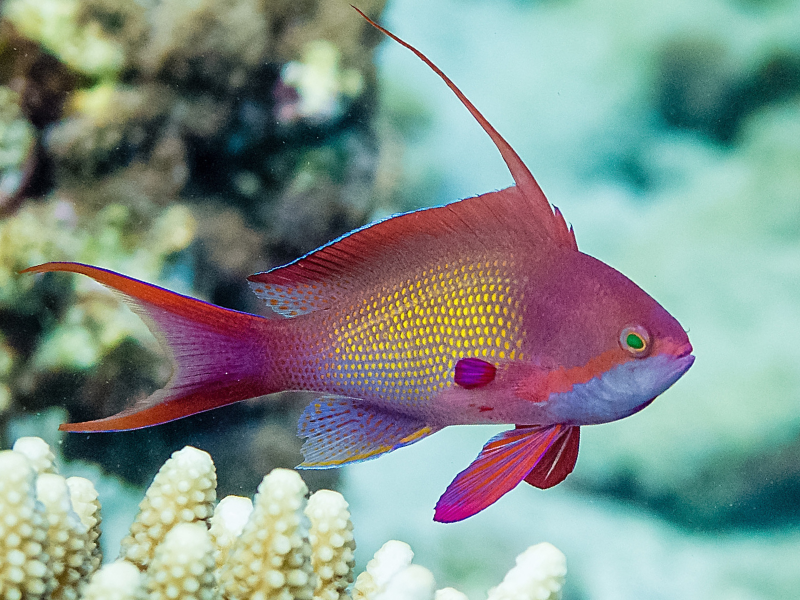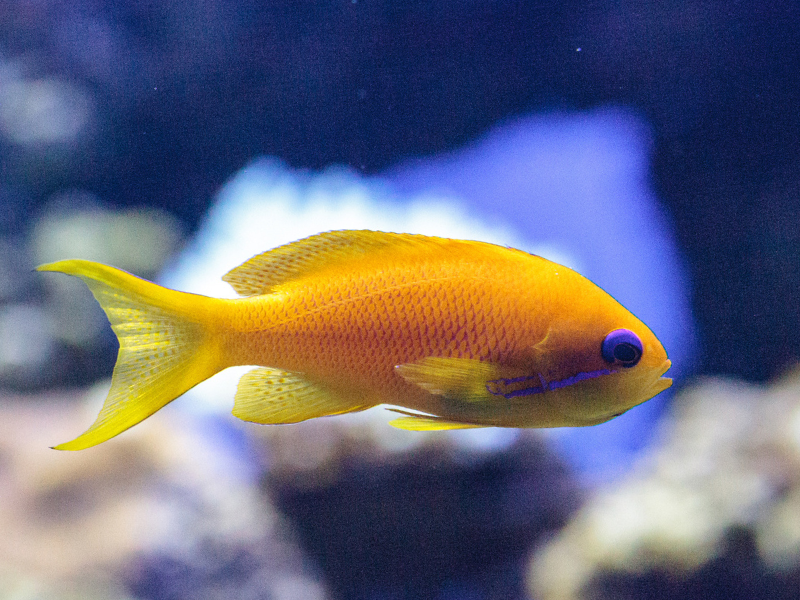Pseudanthias squamipinnis
Lyretail Anthias

Scientific Classification
Quick Stats
Aquarium Building Information
About This Species
Basic Description
Detailed Description
Native to the dynamic reef slopes and drop-offs of the Indo-Pacific, the Lyretail Anthias is a zooplankton-feeding species accustomed to life in strong currents. In the wild, they form immense aggregations that hover over the reef, darting into the water column to capture passing prey. Replicating this environment is the key to their successful captive care. A spacious aquarium with vigorous, high-turnover water movement is not just preferred but essential for their well-being, encouraging natural swimming behavior and aiding in food distribution. Abundant live rock formations with numerous caves and overhangs should be provided to offer security and retreat, although they will spend most of their time in the open water.
One of the most fascinating aspects of this species is its social structure. They are protogynous hermaphrodites, meaning all individuals are born female. In a group, the most dominant female will transition into a male, a process triggered by the absence of a male. Maintaining a group is crucial, with a single male to a harem of several females being the ideal social arrangement. Due to an exceptionally high metabolism rate, a demanding feeding schedule is non-negotiable. Several small feedings per day are required to sustain their energy levels. A varied diet of high-quality, protein-rich foods such as frozen mysis and brine shrimp, copepods, and premium pellets or flakes will ensure their health. Their high activity and frequent feeding result in a significant waste output, necessitating a robust filtration system and a mature tank to handle the bioload. Due to these specific feeding and environmental needs, they are best suited for the dedicated marine hobbyist.
Scientific Description
Pseudanthias squamipinnis is a widely distributed and ecologically significant member of the family Serranidae, inhabiting coral reef ecosystems throughout the Indo-Pacific. Its fusiform body shape is a classic morphological adaptation for a pelagic-feeding lifestyle, allowing for efficient, sustained swimming in high-flow environments and rapid acceleration to capture zooplanktonic prey from the water column. As an active species, it exhibits a high metabolic rate and correspondingly high oxygen consumption, which in a captive setting translates to a substantial bioload and a critical need for high levels of dissolved oxygen and powerful protein skimming for waste management.
The most notable biological characteristic of P. squamipinnis is its reproductive strategy as a protogynous hermaphrodite. Social cues within a shoal dictate sex-change, with the dominant individual in a female-only group or upon the loss of an existing male undergoing a physiological and morphological transformation to become a terminal-phase male. This social hierarchy is fundamental to its population dynamics both in the wild and in aquaria. In its natural habitat, P. squamipinnis forms massive shoals that serve as a vital link in the reef food web, transferring energy from plankton to larger predators. Despite being heavily collected for the aquarium trade, its wide distribution and large population sizes have resulted in its classification as a species of 'Least Concern' on the IUCN Red List, though local populations remain vulnerable to habitat degradation and over-collection.
Breeding Description
Captive breeding of the Lyretail Anthias is a complex and challenging endeavor, generally considered difficult for the average hobbyist. Success hinges on recreating a natural social structure and providing exacting conditions for the larvae. The first step is to establish a healthy, mature harem group in a spacious breeding aquarium. An ideal ratio consists of a single male for a group of at least five to ten females. This larger number of females helps to disperse any potential aggression from the dominant male and encourages natural spawning behavior.
Sexual dimorphism is quite pronounced. Males are typically larger than females and develop distinctly elongated finnage, most notably one of the rays on the dorsal fin. Females are smaller and possess a more uniformly rounded profile. Courtship involves the male performing an energetic display for the females, often occurring near dusk. As pelagic spawners, the pair will dart upwards into the water column, releasing eggs and milt simultaneously. The fertilized eggs are buoyant and will drift with the current.
This spawning method presents the primary challenge. The microscopic eggs are easily lost to filtration or consumed by other tank inhabitants in a standard display tank. A dedicated, bare-bottom breeding system with a specially designed egg collector is almost essential for harvesting the eggs. Upon hatching, the fry are incredibly small and enter a lengthy larval stage. They require an initial diet of microscopic live foods, such as cultured rotifers, followed by enrichment with phytoplankton (the "green water" technique). As they develop, they can be slowly weaned onto larger foods like newly hatched brine shrimp. Maintaining pristine water quality without harming the delicate, free-floating fry is exceptionally difficult, requiring specialized equipment and unwavering dedication.
Sexual Dimorphism
Generate Printable Card
Create a printable card for this creature to display in your store or aquarium. The card includes a QR code for quick access to more information.

